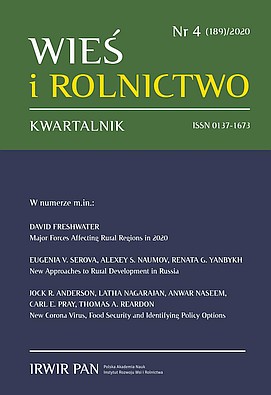A Look at a Small Southern Country: Uruguay
DOI:
https://doi.org/10.53098/wir042020/06Keywords:
Latin America, emerging economies, country studies, COVID-19, UruguayAbstract
In this work we take a look at a small southern country in Latin America: Uruguay, located between two large neighbors: Argentina and Brazil. In the paper some socio-economic features and historical facts about Uruguay were presented. Historically, the agricultural sector and export specialisation have been quite important for the country’s economic growth. Recently, services have become important too. The second part of the paper is entirely dedicated to the present situation, namely from March 2019, in which it was described how the COVID-19 pandemic has been dealt with in terms of the health and economic measures. Finally, some questions about the future of the pandemic and the country’s economy were posed.
References
Bértola L., Isabella F., Saavedra C. (2014). El Ciclo Económico de Uruguay, 1998–2012. Series: Estudios y Perspectivas, No. 16. Montevideo: Oficina de la CEPAL. https://repositorio.cepal.org/bitstream/handle/11362/37521/S1420723_es.pdf
FAO (Food and Agriculture Organization) (2003). General Profile. http://www.fao.org/3/ad934s/ad934s01.htm
Lanzilotta B., Merlo G., Mordecki G. (2020). Coronavirus en Uruguay: Medidas económicas a la talla y el aplanamiento coordinado de las curvas. Blog del Departamento de Economía, 7 abril 2020. http://fcea.edu.uy/images/dto_economia/Blog/Medidas_econ%C3%B3micas_a_la_talla.pdf
Lavalleja M., Rosselot S. (2018). Crecimiento, pobreza y distribución del ingreso en el Uruguay (2006-2016). Series: Estudios y Perspectivas, no. 35. Montevideo: Oficina de la CEPAL. https://repositorio.cepal.org/bitstream/handle/11362/44240/1/S1800918_es.pdf
Maddison A. (2008). Historical Statistics for the World Economy: 1–2006 AD. University of Groningen. Groningen: Maddison Project. DOI: https://doi.org/10.1787/9789264022621-en
MEF (Ministry of Economic and Finance) (2020). Uruguay Sovereign Debt Report January, 2020. Montevideo: Ministry of Economic and Finance. http://deuda.mef.gub.uy/innovaportal/file/28409/2/reporte-de-deuda-soberana-enero-2020.pdf
Mordecki G. (2020). Coyuntura Económica Uruguaya en Épocas de Pandemia. Blog del Departamento de Economía, 6 agosto 2020. http:http://fcea.edu.uy/images/dto_economia/Blog/Coyuntura_uruguaya_en_%C3%A9pocas_de_pandemia.pdf
Paolino C., Pittaluga L., Mondelli M. (2014). Cambios en la Dinámica Agropecuaria y Agroindustrial del Uruguay y las Políticas Públicas. Series: Estudios y Perspectivas, no. 15. Montevideo: Oficina de la CEPAL. https://repositorio.cepal.org/bitstream/handle/11362/36780/1/S2014255_es.pdf
Peluffo A. (2016). Trade Liberalization and Manufacturing Performance: The Uruguayan Case. Saarbrücken: LAP Lambert Academic Publishing.
Sandonato S., Willebald H. (2018). Natural capital, domestic product and proximate causes of economic growth: Uruguay in the long run, 1870–2014. Sustainability, 10 (3), 715. DOI: https://doi.org/10.3390/su10030715











